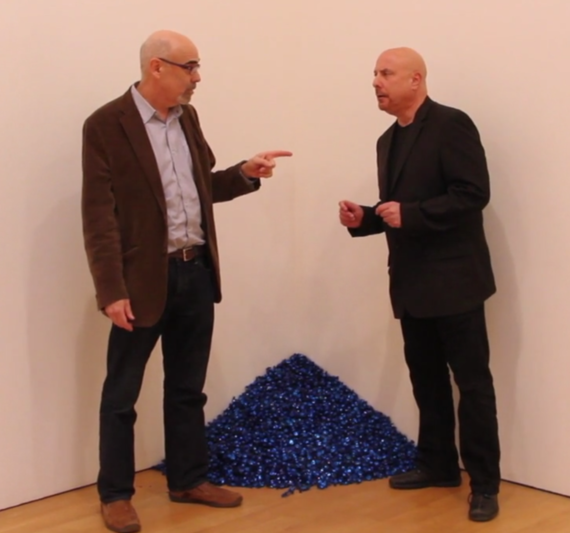"Are you kidding? I mean, Are you KIDDING?"
I was at the Andrea Rosen Gallery with my sister to see
Felix Gonzalez-Torres' new exhibition, most of which
consisted of pounds of candy positioned on the floor
and in various corners around the gallery. It was 1998.
My sister was not an art collector or an art aficionado,
or even anyone with a keen interest in the art world.
She did, however, have opinions. "Okay. Where's the camera?
I thought Alan Funt was dead. I know this is Candid Camera."
We were staring at 100 pounds of candy strewn in the corner.
Each piece wrapped with silver cellophane.
It made me laugh. It was surprisingly beautiful. The candy shimmered as you walked
past, the light catching the different angles of the crinkled paper.
A startling sensory spectacle. I never remembered being this dazzled by candy even as a child. The huge jar of candy my neighbor would put on their porch during Halloween seemed quaint in comparison. When my sisters and I came home from our October 31 excursions we would dump all the candy on the floor and revel in the enormity of our conquest. Still that was a drop in the bucket compared to this.
"How much are they asking for this?" my sister asked.
I got the price list. "$6500 and it's an edition of three."
"You mean three people can buy this pile of candy?
Who in their right mind would buy this? I mean do they think we're idiots?"
I laughed. "If we were smart we'd buy it. Trust me," I said
only half kidding. "Well," my sister said, "put me down as stupid."
"Duly noted," I said.
The truth was I was taken by the simple beauty of the piece.
You were encouraged to take a piece. It was participatory.
You were in essence part of the artwork. An important part. When the candy got low a new batch would take its place. An endless supply of candy, representing, I read, among other things, loss, change, rejuvenation and possibly eternal life as the candy can be forever replenished. (I found out later many of his candy pieces represented
friends and lovers of his. The weight of the candy the same as the person's weight.)
"I can probably get a 10 percent discount too."
"oh yeah? Great. Let's buy it." My sister said
laughing, shaking her head and motioning me
to get the hell out of there before she screamed.
I didn't have the strength or the inclination to give
my sister some art historical perspective.
To discuss with her Duchamp's readymades, or Dada
or minimalism, process art, etc, not that I knew myself
where Gonzalez-Torres inspirations came from.
I left it as just one more inexplicable gallery show.
Did I think $6500 for 100 pounds of candy you could
buy at Costco made sense? Ah, the value of art. I had no
doubt that what I was looking at was art and at least in my mind
successful. However bringing the all mighty dollar into the
equation changes people's outlooks. For me at that moment in time
although I knew it was art, it wasn't "worth" $6500. Not to me.
This past week Christie's sold a Gonazales-Torres candy piece from 1991.
"Untitled" (L.A.) is described in the auction catalogue as
green candies individually wrapped in cellophane, endless supply
overall dimensions vary with installation;
Its ideal weight: 50 lbs (22.7 kg).
It sold for $7,669,000. I called my sister and told her she was right,
she was an idiot.
Years later I was moved to make an episode about the candy pieces
in my web series, The Madness of Art. It remains one of my favorites
because I think it brings all these areas of "What is art?" into play.
Here is that episode:
